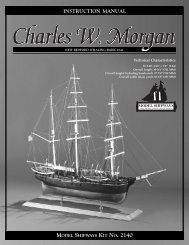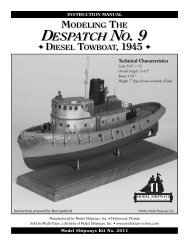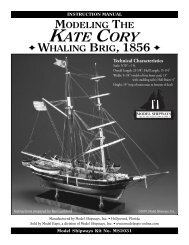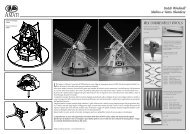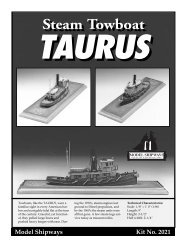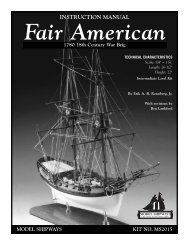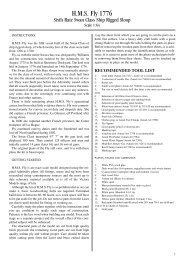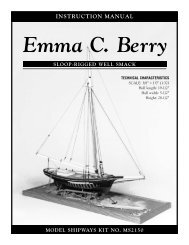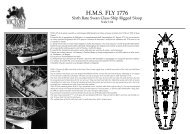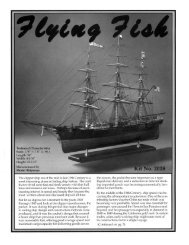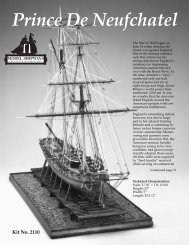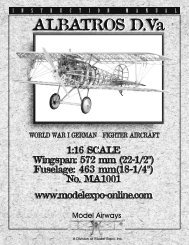download benjamin latham instruction manual
download benjamin latham instruction manual
download benjamin latham instruction manual
Create successful ePaper yourself
Turn your PDF publications into a flip-book with our unique Google optimized e-Paper software.
post. These two planks must have their edges sloped so they<br />
meet flush (see figure 20b). Belt C also has some twists, so<br />
steam bend them in place if necessary.<br />
Laying the Planks in Belt D: This belt will contain the garboard<br />
strake (next to the keel) and two other strakes. It also will contain<br />
two stealers in order to reduce the width aft (see figure<br />
20c). All the planks here will be very wide and must be spiled.<br />
You will need to use the wide planking strips provided in the<br />
kit. Also, you will find that in order for these planks to fit in<br />
place, a severe twist must occur. The planks will have to be<br />
steam bent to obtain the right shape.<br />
The stealers could have been placed in Belt C rather than in<br />
Belt D. However, since the tendency of the lower batten is to<br />
naturally flow upward as it goes aft, placing the stealers in the<br />
lower belt is more logical.<br />
7. Plank Variations within a Belt<br />
If you are working within a belt, and have five planks exactly<br />
the same width, and then find that the last plank in the belt<br />
needs to be made slightly wider to complete the belt ... should<br />
you worry Certainly not. No planking job, even on real ships,<br />
is that precise. You are dealing with hand-cut planks. The important<br />
thing is to keep the flow of planks smooth. A variation<br />
in widths is of no great concern.<br />
8. Planking the Transom<br />
For the model, the side hull planks can be extended past the<br />
transom and the transom planks butted into the hull planks or<br />
vice versa. However, on the real ship, the transom plank meets<br />
the hull plank in a miter joint. If you elect to do this, first cut<br />
the ends of the hull plank that you left hanging over, then add<br />
the 1/16” thick transom planks. Cut the miter on each plank,<br />
then glue them into place (see figure 20d). You could also cut<br />
the miter as you add each side plank.<br />
Plank the inside of the transom with 1/32” stock after the deck<br />
planking is installed. Run the transom planks over to the inside<br />
of the bulwark planking.<br />
9. Planking the Bulwarks<br />
The planks between the planksheer and main rail will be in two<br />
thicknesses. From the planksheer to the waist (see location on<br />
plans), use 1/16”-thick material. Above the waist, use 1/32”-<br />
thick material. The bulwark planks are fairly uniform and will<br />
not require any severe tapering forward or aft. First, fit the<br />
1/16” plank. This will need a jog in it at the deck step as shown<br />
on the plans. Next, fit the 1/32” plank. You may let it extend<br />
slightly above the stanchions. Then, trim it flush with their tops.<br />
Scuppers: Later on in these <strong>instruction</strong>s, there is a discussion<br />
on how to cut or otherwise treat the scuppers which go<br />
through the bulwark planking. If you intend to install the scuppers,<br />
now would be a good time to do it. Cut the scuppers in<br />
the edge of the 1/16” planking before it is installed on the<br />
model (see page 21).<br />
The Cove: Another detail that can be done now before the<br />
planking is installed is the cove, a thin hollow molding, located<br />
just below the waist (see figure 20e). This was an important aesthetic<br />
feature of the fishing schooner and accentuated the low<br />
profile and graceful sheer of the hull. The cove can be scribed<br />
with a sharp steel point and straight edge. If you elect not to<br />
scribe in the cove , do not fail to paint it on (generally, it was gilt).<br />
Fashion Piece: At the transom, there is a fashion piece that<br />
must be fitted (see figure 20f). The piece is 1/32” thick, and<br />
should be added over top of the already installed 1/32” plank.<br />
FIG. 20d – Planking the Transom<br />
Hull plank<br />
Transom<br />
plank<br />
REAL SHIP<br />
FIG. 20f – Fitting the Fashion Piece<br />
FIG. 20g – Installing the Great Beam<br />
Notch for<br />
planksheer<br />
BHD “G”<br />
MODEL<br />
OPTIONS<br />
Miter joint<br />
FASHION PIECE<br />
1/32” – fit on top of<br />
1/32” bulwark plank<br />
Quarter deck plank<br />
Planksheer<br />
Main rail<br />
FIG. 20e – The Cove<br />
Waist<br />
Cove<br />
Bulwark<br />
plank<br />
1/32”<br />
bulwark plank<br />
1/16” plank<br />
Great beam 3/32” thick<br />
Scupper<br />
WAIST<br />
Center keel<br />
Fore deck plank<br />
Scrap deck plank support<br />
10. Planking the Deck<br />
The Great Beam & Plank Supports: Before laying any deck<br />
planking, you must install the great beam (also called a Grub<br />
beam by Essex shipwrights) at the deck step. You must also<br />
add some supporting members under the great beam and<br />
under the edge of the planksheer to provide support for the<br />
ends of deck planks. Cut the great beam to the deck camber<br />
curve. The great beam butts against Bulkhead G and projects<br />
1/16” above it. When the quarter deck planks are installed the<br />
planks will be flush with the top of the great beam. Notch the<br />
ends of the great beam to fit over the fore deck planksheer (see<br />
figure 20g). The sketch shows the construction of the great<br />
beam and the supports (see also figure 21).<br />
17



